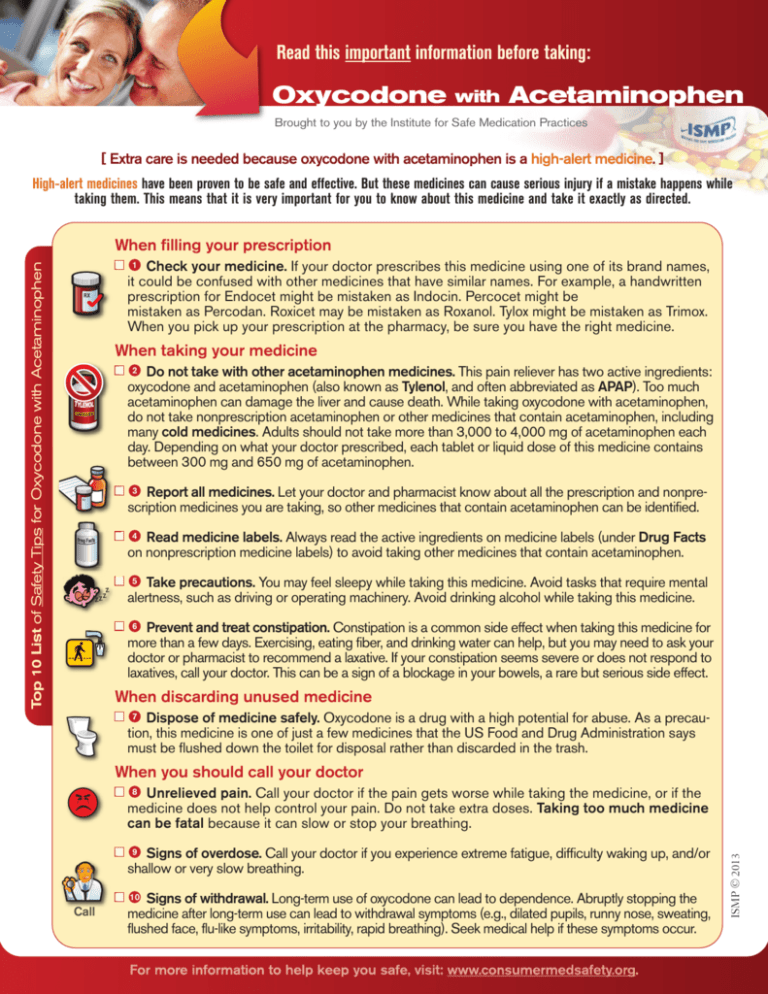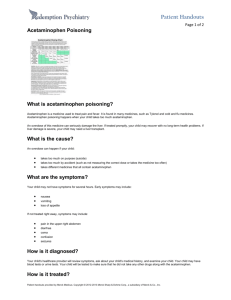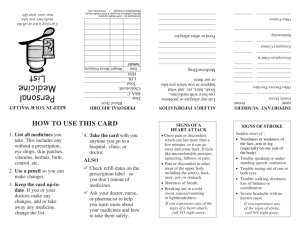Oxycodone with Acetaminophen - Institute For Safe Medication
advertisement

Read this important information before taking: Oxycodone with Acetaminophen Brought to you by the Institute for Safe Medication Practices [ Extra care is needed because oxycodone with acetaminophen is a high-alert medicine. ] High-alert medicines have been proven to be safe and effective. But these medicines can cause serious injury if a mistake happens while taking them. This means that it is very important for you to know about this medicine and take it exactly as directed. Check your medicine. If your doctor prescribes this medicine using one of its brand names, it could be confused with other medicines that have similar names. For example, a handwritten prescription for Endocet might be mistaken as Indocin. Percocet might be mistaken as Percodan. Roxicet may be mistaken as Roxanol. Tylox might be mistaken as Trimox. When you pick up your prescription at the pharmacy, be sure you have the right medicine. 1 RX When taking your medicine Do not take with other acetaminophen medicines. This pain reliever has two active ingredients: oxycodone and acetaminophen (also known as Tylenol, and often abbreviated as APAP). Too much acetaminophen can damage the liver and cause death. While taking oxycodone with acetaminophen, do not take nonprescription acetaminophen or other medicines that contain acetaminophen, including many cold medicines. Adults should not take more than 3,000 to 4,000 mg of acetaminophen each day. Depending on what your doctor prescribed, each tablet or liquid dose of this medicine contains between 300 mg and 650 mg of acetaminophen. 2 Report all medicines. Let your doctor and pharmacist know about all the prescription and nonprescription medicines you are taking, so other medicines that contain acetaminophen can be identified. 3 RX Read medicine labels. Always read the active ingredients on medicine labels (under Drug Facts on nonprescription medicine labels) to avoid taking other medicines that contain acetaminophen. 4 Take precautions. You may feel sleepy while taking this medicine. Avoid tasks that require mental alertness, such as driving or operating machinery. Avoid drinking alcohol while taking this medicine. 5 Prevent and treat constipation. Constipation is a common side effect when taking this medicine for more than a few days. Exercising, eating fiber, and drinking water can help, but you may need to ask your doctor or pharmacist to recommend a laxative. If your constipation seems severe or does not respond to laxatives, call your doctor. This can be a sign of a blockage in your bowels, a rare but serious side effect. 6 When discarding unused medicine Dispose of medicine safely. Oxycodone is a drug with a high potential for abuse. As a precaution, this medicine is one of just a few medicines that the US Food and Drug Administration says must be flushed down the toilet for disposal rather than discarded in the trash. 7 When you should call your doctor Unrelieved pain. Call your doctor if the pain gets worse while taking the medicine, or if the medicine does not help control your pain. Do not take extra doses. Taking too much medicine can be fatal because it can slow or stop your breathing. 8 Signs of overdose. Call your doctor if you experience extreme fatigue, difficulty waking up, and/or shallow or very slow breathing. 9 Signs of withdrawal. Long-term use of oxycodone can lead to dependence. Abruptly stopping the medicine after long-term use can lead to withdrawal symptoms (e.g., dilated pupils, runny nose, sweating, flushed face, flu-like symptoms, irritability, rapid breathing). Seek medical help if these symptoms occur. 10 Call ISMP © 2013 Top 10 List of Safety Tips for Oxycodone with Acetaminophen When filling your prescription Oxycodone with Acetaminophen Read these Fast Facts about your medicine! Topics Generic name Common brand names Uses Usual dose limits Special instructions and precautions Possible drug dependence with long-term use Safety during pregnancy/breastfeeding Tell your doctor if you have: Storage and disposal Side effects to report to your doctor immediately Other conditions to report to your doctor Nonprescription medicines/herbals that should not be taken with oxycodone and acetaminophen Prescription medicines that should not be taken with oxycodone and acetaminophen Fast Facts oxycodone and acetaminophen (pronounced oks i KOE done and a seet a MIN oh fen) (generic available) Percocet, Endocet, Roxicet, Roxicet 5/500, Magnacet, Primlev, Xolox Treats moderate to severe pain Moderate pain: 21/2 (2.5) to 5 mg of oxycodone every 4 to 6 hours as needed for pain Severe pain: 10 mg of oxycodone every 4 to 6 hours as needed for pain Do not take more than 3,000 to 4,000 mg of acetaminophen each day (depending on what your doctor prescribed, each tablet or liquid dose contains between 300 mg and 650 mg of acetaminophen) Take the medicine exactly as prescribed Call your doctor if your pain is not relieved; do not take an extra dose Do not take regular acetaminophen (Tylenol) while taking this medicine While taking this medicine, do not take nonprescription cough and cold medicines or other medicines that contain acetaminophen Do not drive or operate machinery while taking this medicine because it may make you sleepy and impair your coordination; use caution when climbing stairs Avoid drinking alcohol while taking this medicine Do not start or stop any medicine, including nonprescription medicines, herbals, and vitamins, without letting your doctor or pharmacist know Oxycodone is an opioid that causes an exaggerated sense of well-being, which can lead to physical and psychological dependence with long-term use Abruptly stopping the medicine after long-term use can lead to withdrawal symptoms (see safety tip #10 on front side of page) Serious dependence rarely occurs when the medicine is taken as prescribed for short-term relief of pain Tell your doctor if you are pregnant or become pregnant Use of this medicine during pregnancy may produce physical dependence in a newborn Avoid taking this medicine for long periods or in high doses near your due date Oxycodone enters breast milk, so it is best to limit intake and use caution If taken while breastfeeding, let your baby’s doctor know, take doses immediately after breastfeeding or 3 to 4 hours before the next feeding, and immediately report changes in your baby, such as increased sleepiness (beyond the usual), breathing difficulties, changes in the baby’s feeding pattern, or limpness Diseases: liver disease, lung disease, breathing problems, heart disease, a head injury, history of seizures, thyroid disorder, Addison’s disease Allergies to: acetaminophen, codeine, other powerful pain relievers Been taking illicit drugs or drink 3 or more alcoholic beverages daily Store at room temperature, protect from moisture Flush any unused medicine down the toilet Keep in a secure area away from children (and teenagers, for whom reports of abuse with this drug are common) Difficulty breathing, very slow breathing, persistent dizziness or headache, excessive sleepiness, confusion, weakness, trembling, blurred vision, vomiting, allergic reaction Constipation, nausea Acetaminophen (including Tylenol) Cough and cold medicines that contain acetaminophen St. John’s wort Other prescription medicine that contains acetaminophen Sedatives, tranquilizers, antihistamines, other strong pain medicines Alvimopan (Entereg), imatinib (Gleevec) This information does not replace the need to follow your doctor’s instructions and read the drug information leaflet provided with your prescription. This project was supported by grant number R18HS017910 from the Agency for Healthcare Research and Quality. The content is solely the responsibility of the authors and does not represent the official views of the Agency for Healthcare Research and Quality.



